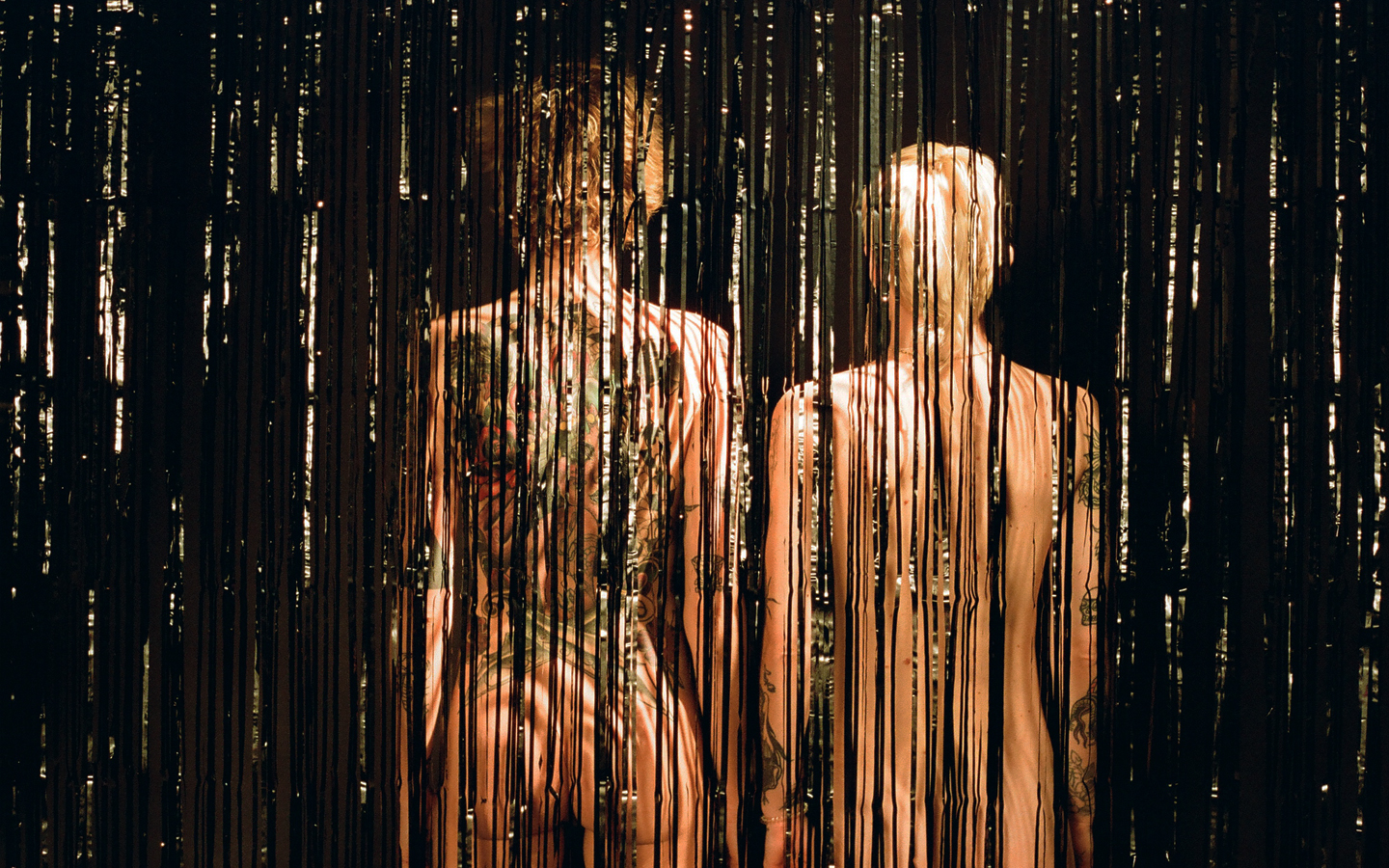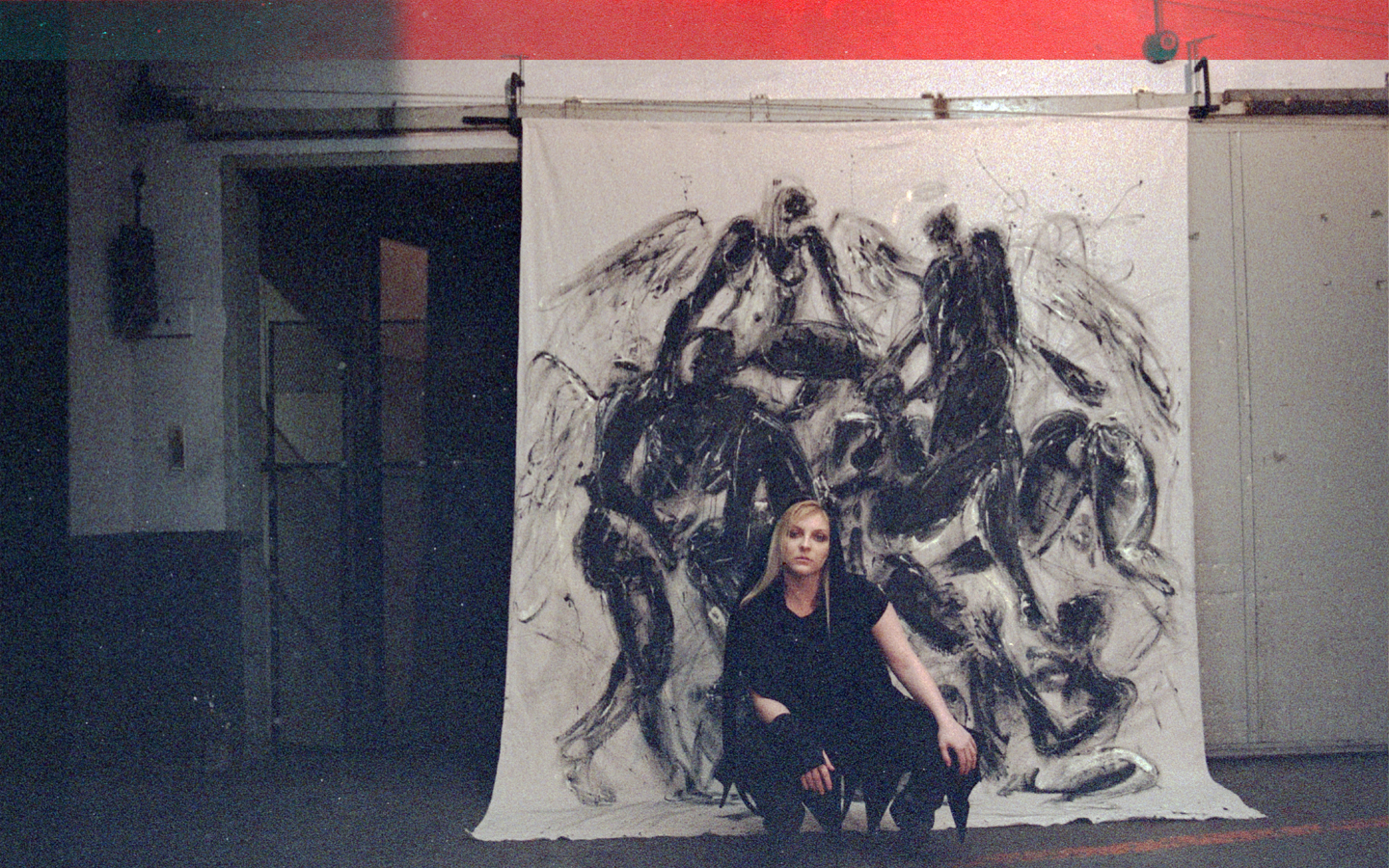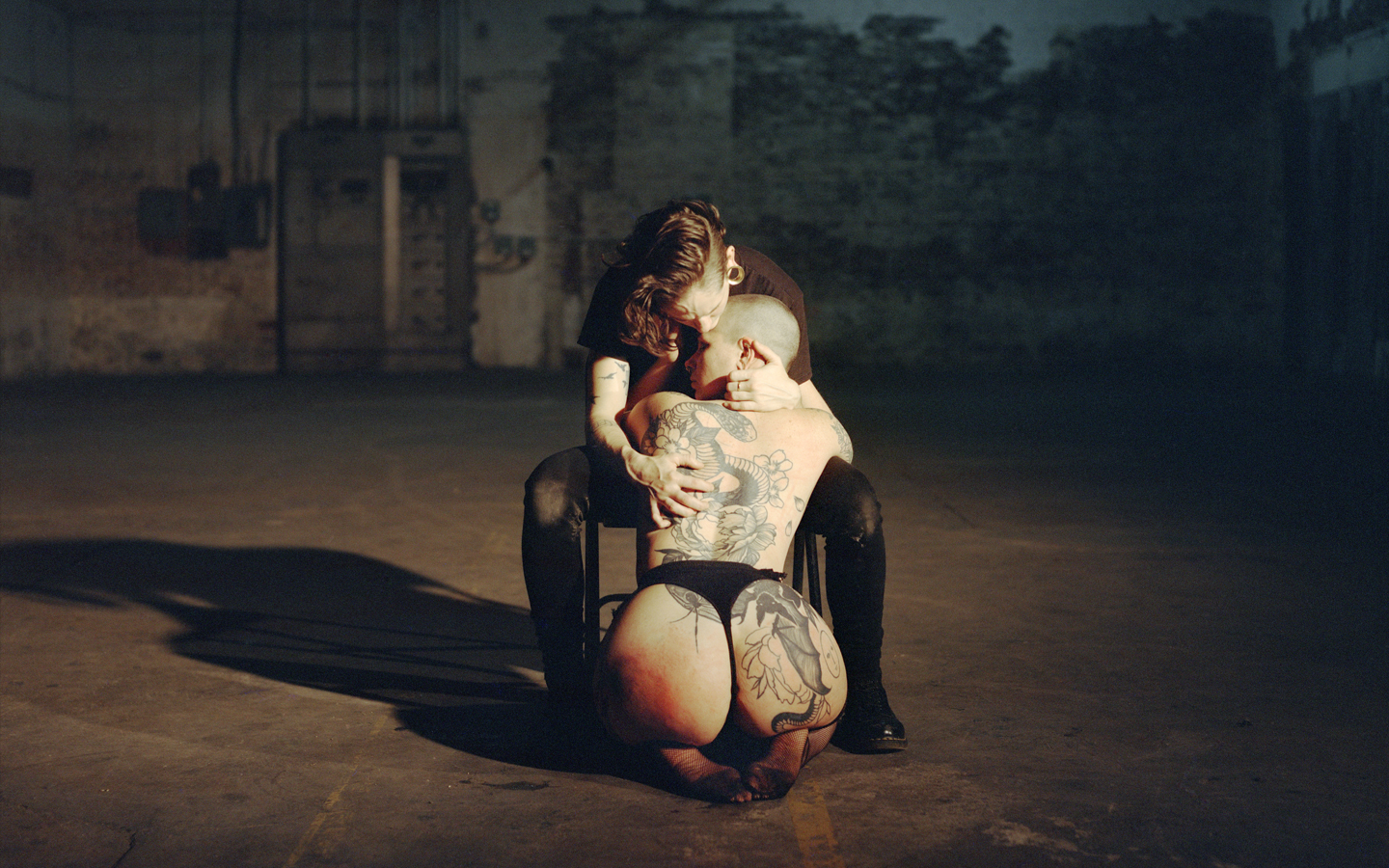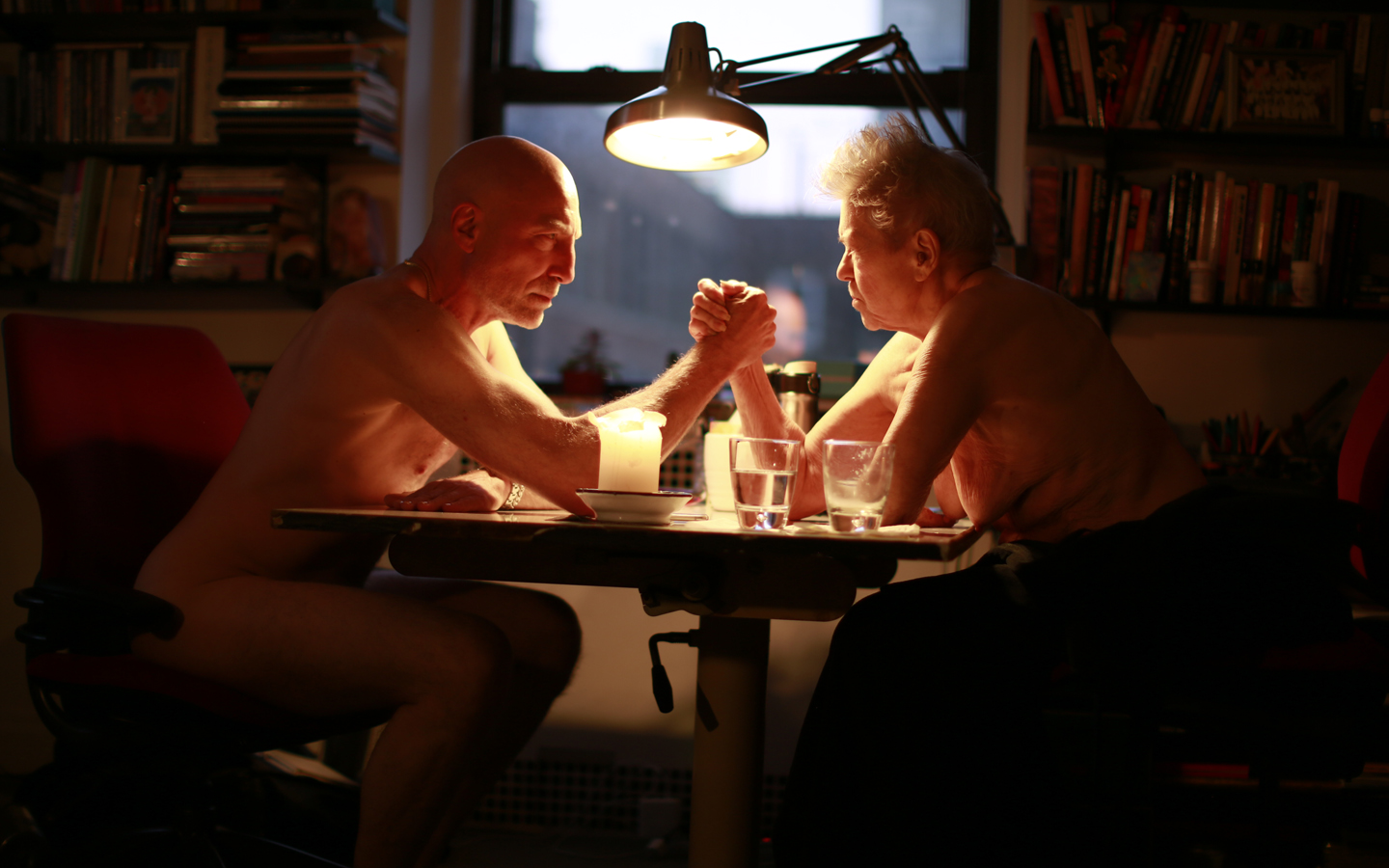
(Gender) Binary Codes
text VANESSA DE HORSEY
35mm film VIKTORIA RAYKOVA
Identity is relentlessly complex; there’s the person we feel we truly are, the person we present to the public, the person we present to those we deeply trust, and the different versions of ourselves that other people see—informed by their own understandings, assumptions, desires, biases. The version we put forth on a daily basis is often determined by a combination of overt and invisible social codes that surround us: physical, social, emotional, professional, familial, political—expectations that take many forms, endless rules that we follow (or break). We make adjustments conscious or subconscious decisions—to conceal our true selves in order to survive, some of us much more literally than figuratively. I think about my true self, and how embodying the feelings that are reflective of my ‘true self’ provide relief, comfort, a will to live, even joy. The moments where the authentic self must be suppressed, modified, or watered down feel like living with a lack of oxygen; those experiences accumulate over time into existential pain and physical exhaustion. Compared to others, the adjustments I have to make are relatively minor; it’s painful to imagine putting an exponent on such severe compromises.
On a hot October day, I meet with Adam and Vicky to speak about gender, sexuality, identity, and what it means to navigate a world that is built on unflinching binaries. Adam is 21-years-old, non-binary, transmasculine, and uses pronouns “he” and “they.” Adam sits to my right; he has dark brown hair and a short beard. Their silver septum ring threatens to fall out repeatedly; they adjust it a few times and, in one startling moment, catch the ring before it tumbles into their salad.
Vicky is 30-years-old, non-binary, asexual, and uses pronouns “he,” “she,” and “they.” They sit to my left. He has black hair, black facial hair, and traces of fake blood behind his ear from last night’s drag performance. I love fake blood. She drinks an iced chai and I notice her long nails with chipped black polish. I also love iced chai.
On a cool October night, it occurs to me that I don’t actually know how to ‘correctly’ use pronouns when a person has multiple preferences. The quest for understanding continues as follows: I research for answers, open over a dozen tabs, lose my Wi-Fi connection, get my Wi-Fi connection back, get into a Reddit rabbit hole, rephrase and use different keywords, open more tabs, close a dozen tabs of unhelpful articles, and then drink a glass of wine while watching PBS to calm down.
The glaring lack of public information feels lazily ironic, the reality of its implications only reinforcing the frustrations of dealing with a world that doesn’t seem to want to move beyond its iron structures. Feeling like a fucking idiot, I think about how much easier it would be if we weren’t so adamant about forcing people into strict identities. It’s not a difficult reality to imagine; it almost seems too obvious. Vicky told us about playing house in preschool, dressing up the way children often do, and then finding out that a boy told on him for cross-dressing. The teacher wasn’t concerned. “That part is cemented in my brain, where the teacher said that what I was doing was just dressing up, just playing,” Vicky relates.
We have predispositions as humans, inherent curiosities. And then we’re taught, implicitly or explicitly, what is acceptable—how to act, how to treat others, how to let others treat us. Internal alarms sounded off when one child saw another child express themselves outside of established expectations. The innocent, once instilled with oppressive values, quickly become the oppressor. He was taught to feel that way.
These are crucial moments: having your innocence crushed, being shamed, feeling guilt for the first time and not necessarily understanding why. Vicky tells me: “I have this memory where my mom is calling me for dinner, and she’s saying “VICTOR! VICTOR!” And I’d yell back, “MY NAME’S VICTORIA! AND I’M A GIRL!” I wouldn’t go until she’d call me Victoria.” Vicky’s identity was initially something they felt comfortable owning. Then suddenly, that freedom is strangled; reality crashes down. “I remember being a kid,” Vicky continued, “being fluid, and not worrying about those things… and then growing up and realizing that I had to worry about those things.” Vicky went on: “You grow up in a toxic-masculine mind frame, constantly suppressing your anxiety about your sexuality, or your anxiety about your gender, what you’re presenting, how you’re perceived… Once you break it down, it’s a lot to process.”
For many of us, there has to be an ongoing process of learning and unlearning: letting go of what has been drilled into our brains and creating space within ourselves to be more open-minded, whether to accept others or ourselves.
⁂
Consider how often we blindly follow arbitrary rules and the people who create them. Social norms and codes influence the majority more than most of us realize; legislation is not a result of pure ethics, it is a result of specific values. Once we finally evolve, we find ourselves looking over the past—wishing, with a sigh, that we had been more enlightened. As if no alternative existed, as if we aren’t completely capable of thinking for ourselves. We promise not to make the same mistakes, not to hurt each other again, and then we watch as history repeats itself. Those of us who have suffered remember feeling trapped and helpless, our decisions not mattering. The scars fade but are still visible.
The insidious nature of our social norms comes to light as the conversation progresses. Vicky points to the anxiety of presentation: even if we manage to understand ourselves, we have to constantly brace ourselves for the eyes of others. “When I’m out I try to present more masculine, even though that’s not how I’d like to ultimately present myself to the world—I just feel safer,” Vicky explains. “Even having painted nails in public, people treat you differently, and that’s such a small thing.” I would guess that most people have experienced judgment and hostility for something as benign as nail polish. Over time, we learn to anticipate reactions and protect ourselves as best we can, delicately balancing our internal needs with external pressures. But why should these two things be at odds with one another? Adam’s experiences with masculinity seem to highlight this paradigm: “I have to tone down being effeminate,” Adam says. “Especially in trans-masculine spaces, there’s a lot of hyper-masculinity and a lot of different notions about how to pass, or how to be a “man’s man”—and I think that passing is such a toxic concept. Instead of teaching trans people how to hate their bodies, we need to educate people to be okay with who we really are.”
Masculinity exists as its own binary, both a safety blanket and a suffocating oppressor. The existing binaries don’t need to be completely destroyed—they just need to be opened, examined, mended. We need to make conscious decisions to create room for more than two options. I start considering my own need to align my external presentation with my internal feelings as Vicky talks about their own process of understanding their identity. “I’ve always been drawn to feminine things, but as time went on, I just didn’t identify with the binary,” Vicky explains. “I’ve always been attracted to the in-between state. I feel like I’m always kind of stuck between ‘masculine woman’ or ‘feminine man,’ and those are my two modes. It just depends on what I’m wearing—like, this outfit is just another version of drag to me, it’s another lie. The masculinity that I wear is the same lie as the femininity that I wear. I don’t act differently when I’m in drag. I’m the same, it’s just clothes to me.”
It’s a lie. It’s a lie. It’s a lie.
I try to visualize the gender binary and see massive iron boxes with their lids soldered shut. Some people are trying to pry them open, others are trying to escape; some sit comfortably within them, reinforcing their structures and ignoring those who struggle around them. While these boxes still exist, the shadows they cast and the pain they cause cannot be ignored. These issues reach far beyond physical representation; those outside the gender binary have more pressing needs, as Adam attests. “I feel like there needs to be a bigger dialogue than about our bodies. We need to begin conversations about the social and economic aspects of who we are as a community—try to analyze what we’re doing, where we’re going wrong, and how to get on the right path. It’s tiring to repeat the same painful story over and over again. A lot of them look the same or are very similar to each other, and we can relate for sure, but when are we going to get to the real growth in our communities?”
One could say that over time, we will naturally move away from the gender binary and its tight grip. But the social, economic, everyday experiences that it influences are what need attention now. How much more time are we really going to spend keeping our focus on what people are wearing? A clear answer is that loyalty to the binary upholds specific power structures in our society, and there are obvious reasons for certain groups to prevent identities that challenge these structures from being acceptable.
If we ever get to the point of being post-gender, many of our oppressive social dynamics—and many of the people who benefit from those dynamics—would not continue to thrive. Without the existing gender hierarchies and the prescribed expectations for each person to perform both physically and emotionally under a strict set of gendered rules, we might all live more easily as individuals. As we work to address and dismantle the many forms of inequality, injustice and intolerance in our society, breaking free from the gender binary is one step we can all take that could have universal benefits. So why don’t we?




